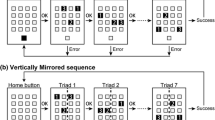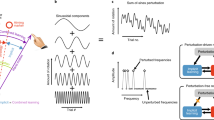Abstract
One major assumption in the field of implicit learning is that implicit learning processes directly affect performance without further top-down control (e.g., Destrebecqz and Cleeremans 2003). In three related experiments, the authors tested the so-called “Not Letting Go Phenomenon” (Schneider and Fisk in J Exp Psychol Learn Mem Cogn 8:261–278, 1982); that is, the assumption that accuracy instructions might impair the effect of implicit learning processes during skill acquisition. Results of Experiment 1 show that accuracy instructions can impair both, the behavioral and metacognitive effects of implicit learning. Experiments 2 and 3 indicate that this impairment is due more to an impairment of the performance effects of implicit learning processes than to a direct impairment of the learning processes, per se. While these results are in accordance with recent findings in skill acquisition showing that monitoring processes impede experts’ performance, they seem to contradict the above mentioned assumption that implicit learning processes directly affect performance.


Similar content being viewed by others
Notes
We did not analyze input position 4 which is also determined by the systematicity underlying the regular task set. In the regular task set, this response always results from the much easier comparison of two identical digits whereas in the random task set the response to input position 4 also requires comparing two nonidentical digits. This difference in difficulty might conceal the effect of implicit learning.
An alternative method for the purpose of equalizing participants’ response times is to use the so-called deadline procedure (e.g., Jones & Jacoby, 2005). This procedure requires participants to respond within a given time window. However, one problem with using this kind of procedure for one single condition is that participants have to conduct a dual-task. That is, they have to solve the original task and in addition must attend to the response signal. This might lead to fewer attentional resources at their disposal. Therefore, we decided to lengthen the RSI.
References
Anderson, J. R. (1993). Rules of the mind. Hillsdale: Erlbaum.
Beilock, S. L., Bertenthal, B. I., McCoy, A. M., & Carr, T. H. (2004a). Haste does not always make waste: expertise, direction of attention, and speed versus accuracy in sensorimotor skills. Psychonomic Bulletin and Review, 11, 372–379.
Beilock, S. L., & Carr, T. H. (2001). On the fragility of skilled performance: what governs choking under pressure? Journal of Experimental Psychology: General, 130, 701–725.
Beilock, S. L., & Carr, T. H. (2005). When high powered people fail: working memory and “choking under pressure” in math. Psychological Science, 16, 101–105.
Beilock, S. L., Kulp, C. A., Holt, L. E., & Carr, T. H. (2004b). More of the fragility of perfromance: choking under pressure in mathematical problem solving. Journal of Experimental Psychology: General, 133, 584–600.
Buchner, A., Steffens, M. C., Erdfelder, E., & Rothkegel, R. (1997). A multinomial model to assess fluency and recollection in a sequence learning task. The Quarterly Journal of Experimental Psychology, 50A, 631–663.
Destrebecqz, A., & Cleeremans, A. (2001). Can sequence learning be implicit? New evidence with the process dissociation procedure. Psychonomic Bulletin and Review, 8, 343–350.
Destrebecqz, A., & Cleeremans, A. (2003). Temporal factors in sequence learning. In L. Jiménez (Ed.), Attention and implicit learning. Amsterdam: John Benjamins.
Dienes, Z., & Perner, J. (1999). A theory of implicit and explicit knowledge. Behavioral and Brain Sciences, 22, 735–808.
Frensch P. A., Haider, H., Rünger, D., Neugebauer, U., Voigt, S., Werg, J. (2003). Verbal report of incidentally experienced environmental regularity: the route from implicit learning to verbal expression of what has been learned. In L. Jiménez (Ed.), Attention and implicit learning. Amsterdam und Philadelphia: J. Benjamin Publishers.
Frensch, P. A., Lin, J., & Buchner, A. (1998). Learning versus behavioral expression of the learned. The effects of a secondary tone counting task on implicit learning in the serial reaction time task. Psychological Research, 61, 83–98.
Grosjean, M., Rosenbaum, D. A., & Elsinger, C. (2001). Timing and reaction time. Journal of Experimental Psychology: General, 130, 256–272.
Haider, H., & Frensch, P. A. (1999). Information reduction during skill acquisition: the influence of task instruction. Journal of Experimental Psychology: Applied, 2, 129–151.
Haider, H., & Frensch, P. A. (2005). The generation of conscious awareness in an incidental leaning situation. Psychological Research, 69, 399–411.
Haider, H. & Frensch, P. A. (2008). The ability to verbally describe task regularities: is it simply a mandatory consequence of memory strength? Psychological Research (in press).
Hertzog, C., Vernon, M. C., & Rypma, B. (1993). Age differences in mental rotation task performance: the influence of speed/accuracy tradeoffs. Journal of Gerontology: Psychological Sciences, 48, 150–156.
Hommel, B. (2003). Acquisition and control of voluntary action. In S. Maasen, W. Prinz, & G. Roth (Eds.). Voluntary Action (Chapter 2). Oxford: Oxford University Press.
Kinder, A., & Shanks, D. R. (2003). Neuropsychological dissociation between priming and recognition: a single-system connectionist account. Psychological Review, 110, 728–744.
Jones, T. C., & Jacoby, L. L. (2005). Conjunction errors in recognition memory: modality-free errors for older adults but not for younger adults. Acta Psychologica, 120, 55–73.
Koriat, A. (1997). Monitoring one’s own knowledge during study: a cue-utilization approach to judgments of learning. Journal of Experimental Psychology: General, 126, 349–370.
Koriat, A. (2000). The feeling of knowing. Some metatheoretical implications for consciousness and control. Consciousness and Cognition, 9, 149–171.
Koriat, A., Ma’ayan, H., & Nussinson, R. (2006). The intricate relationships between monitoring and control in metacogntion: lessons for the cause-and-effect relation between subjective experience and behavior. Journal of Experimental Psychology: General, 135, 36–69.
Logan, G. D. (1988). Toward an instance theory of automatization. Psychological Review, 95, 492–527.
Logan, G. D. (1992). Shapes of reaction-time distributions and shapes of learning curves: a test of the instance theory of automatization. Journal of Experimental Psychology: Learning, Memory, and Cognition, 18, 883–914.
Logan, G. D. (2002). An instance theory of attention and memory. Psychological Review, 109, 376–400.
Loftus, G. R., & Masson, M. E. J. (1994). Using confidence intervals in within-subject designs. Psychonomic Bulletin and Review, 1, 476–490.
May, C. P., Hasher, L., & Foong, N. (2005). Implicit memory, age, and time of day: paradoxical priming effects. Psychological Science, 16, 96–100.
Mayr, U. (2001). Age differences in the selection of mental sets: the role of inhibition, stimulus ambiguity, and response-set overlap. Psychology and Aging, 16, 96–109.
Reber, P. J., & Squire, L. R. (1994). Parallel brain systems for learning with and without awareness. Learning and Memory, 1, 217–229.
Rickard, T. C. (1997). Bending the power law: a CMPL theory of strategy shifts and the automatization of cognitive skills. Journal of Experimental Psychology: General, 126, 288–311.
Rogers, W. A., & Gilbert, D. K. (1997). Do performance strategies mediate age-related differences in associative learning? Psychology and Aging, 12, 620–633.
Rogers, W. A., Hertzog, C., & Fisk, A. D. (2000). Age-related differences in associative learning: an individual differences analysis of ability and strategy influences. Journal of Experimental Psychology: Learning, Memory, and Cognition, 26, 359–394.
Schneider, W. (1985a). Toward a model of attention and the development of automatic processing. In M. I. Posner, & O. S. Marin (Eds.). Attention and Performance, XI (pp. 475–492). Hillsdale: Erlbaum.
Schneider, W. (1985b). Training high-performance skills: fallacies and guidelines. Human Factors, 27, 285–300.
Schneider, W., & Fisk, A. D. (1982). Concurrent automatic and controlled visual search: can processing occur without resource cost? Journal of Experimental Psychology: Learning Memory, and Cognition, 8, 261–278.
Schneider, W., & Fisk, A. D. (1983). Attention theory and mechanisms for skilled performance. In R. A. Magill (Ed.), Memory and control of action. Amsterdam: North-Holland Pub. Co.
Shin, J. C., & Ivry, R. B. (2002). Concurrent learning of temporal and spatial sequences. Journal of Experimental Psychology: Learning, Memory, and Cognition, 28, 445–457.
Strayer, D. L., & Kramer, A. F. (1994). Strategies and automaticity: I. Basic findings and conceptual framework. Journal of Experimental Psychology: Learning, Memory, and Cognition, 20, 318–341.
Thurstone, L. L., & Thurstone, T. G. (1941). Factorial studies of intelligence. Psychometric Monographs, 2, 94.
Touron, D. R., Hoyer, W. J., & Cerella, J. (2004). Cognitive skill acquisition in strategy shifts and speed of component operations. Psychology and Aging, 19, 565–580.
Touron, D. R., & Hertzog, C. (2004). Distinguishing age differences in knowledge, strategy use, and confidence during strategic skill acquisition. Psychology and Aging, 19, 452–466.
Wagner, U., Gais, S., Haider, H., Verleger, R., & Born, J. (2004). Sleep inspires insight. Nature, 427, 352–355.
Whittlesea, B. W. A., & Price, J. R. (2001). Implicit/explicit memory versus analytic/nonanalytic processing: Rethinking the mere exposure effect. Memory & Cognition, 29, 234–246.
Whittlesea, B. W. A., & Williams, L. D. (2000). The source of feelings of familiarity: the discrepancy- attribution hypothesis. Journal of Experimental Psychology: Learning, Memory, and Cognition, 26, 547–565.
Whittlesea, B. W. A., & Williams, L. D. (2001). The discrepancy—attribution hypothesis: I. The heuristic basis of feelings of familiarity. Journal of Experimental Psychology: Learning, Memory, and Cognition, 27, 3–13.
Willingham, D. B. (1998). A neuropsychological theory of motor skill learning. Psychological Review, 105, 558–584.
Willingham, D. B., Greenberg, A. R., & Thomas, R. C. (1997). Response-to-stimulus interval does not affect implicit motor sequence learning, but does affect performance. Memory and Cognition, 25, 534–542.
Woltz, D. J., Bell, B. G., Kyllonen, P. C., & Gardner, M. K. (1996). Memory for order of operations in the acquisition and transfer of sequential cognitive skills. Journal of Experimental Psychology: Learning, Memory, and Cognition, 22, 438–457.
Woltz, D. J., Gardner, M. K., & Bell, B. G. (2000). Negative transfer in sequential cognitive skills: strong-but-wrong sequence application. Journal of Experimental Psychology: Learning, Memory, and Cognition, 26, 601–625.
Author information
Authors and Affiliations
Corresponding author
Rights and permissions
About this article
Cite this article
Hoyndorf, A., Haider, H. The “Not Letting Go” phenomenon: accuracy instructions can impair behavioral and metacognitive effects of implicit learning processes. Psychological Research 73, 695–706 (2009). https://doi.org/10.1007/s00426-008-0180-4
Received:
Accepted:
Published:
Issue Date:
DOI: https://doi.org/10.1007/s00426-008-0180-4




